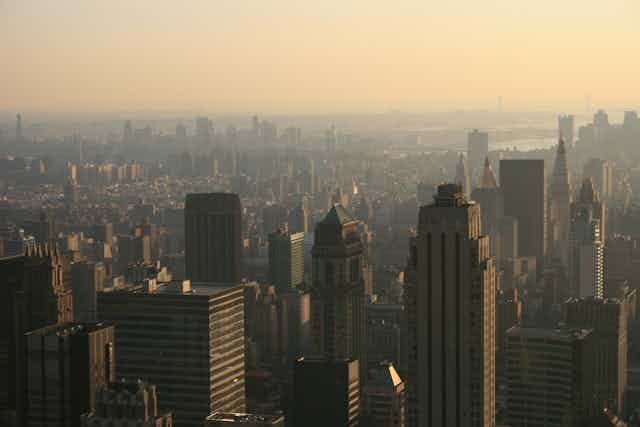On October 1, the US Environmental Protection Agency announced new standards for ground-level ozone. Much of the discussion around the new regulations has centered either on whether they are protective enough of health or on how much implementation will cost.
The US is not the only country taking action to restrict ground-level ozone – and from a health perspective, even the new, lower US limit is still higher than guideline levels in other countries.
Industry in the US has resisted tighter controls on ozone because they would require upgrades to air quality equipment at power plants, industrial activity and vehicles. However, a true accounting of the costs and benefit should include the health and ecological benefits of stricter controls.
Damaging impact
Wherever it comes from, ground-level ozone can cause substantial damage to human health, including respiratory problems, asthma attacks, and premature mortalities. Ozone impacts the environment, too, by harming plant growth and lowering agricultural crop yields. Ozone can also act as a greenhouse gas, contributing to warming of the climate.

While ground-level ozone is primarily a regional issue, pollutants that can contribute to ozone formation also travel across continents. For example, emissions from Asia contribute to local ground-level ozone problems in the United States.
Much discussion of the new EPA rule has focused on the issue of compliance costs, with very different estimates of the economic implications of meeting the new standard.
However, the health and ecological impacts of ozone have an economic cost as well – and these can add up. In the US, for example, the EPA estimates that strengthening the standards could lead to US$2.9-5.9 billion in benefits from improved health.
Comparing numbers
The new ambient air quality standard was reduced from a level of 75 parts per billion (ppb) of allowed ground-level ozone in air to 70 ppb. This is at the top end of the range – 60 to 70 ppb – recommended by the scientific advisory committee tasked with informing EPA about this issue.
A concentration of 70 ppb is still a high level of ozone when compared with targets set by other countries around the world. Ozone concentrations are often averaged over eight hours. As ozone forms from chemical reactions that include sunlight and temperature, the maximum level usually occurs in the afternoons.
The World Health Organization’s health-based guideline (a recommendation only - the WHO is not a regulatory body) for all its member states is equivalent to 50 ppb. The European Union (EU) aims for a long-term objective to protect health that corresponds to 60 ppb, and Canada’s standard is 63 ppb. Research has also shown that the negative health effects of ozone can occur at concentrations far below these levels.
However, it is difficult to compare regulations directly, as both the form and the enforcement capacity differ.
The US regulation allows the set level to be exceeded up to four times per year, before deeming an area to be violating the standard. The EU’s level represents a long-term objective – in the near term, concentrations can exceed the target level up to 25 times, averaged over three years. Canada’s standard, while measured similarly to the US, is essentially a voluntary target, with little enforcement capacity.
In practice, both in the US and elsewhere, ozone concentrations frequently fail to meet the standards. Based on 2012-2014 data, 241 counties in the US had concentrations that exceeded the new standard. In the summer of 2014, the EU did not meet its long-term objective at 80% of measurement stations.
In other parts of the world ozone is an even more widespread problem. High levels of industrial and traffic emissions in Asia lead to high ozone concentrations there that can far exceed levels in North America and Europe.
Connection to greenhouse gases
Regulatory actions aren’t the only factor in controlling ozone levels. Because ozone is produced in the atmosphere, its formation can also be affected by meteorological conditions.
In many areas in the US – in particular, densely populated areas where people live such as the East, Midwest, and South – it is projected that climate change can make ozone worse, because changes like increasing temperature can increase ozone formation.
By 2050, it has been estimated that the global health costs from ozone could reach $580 billion, considering both climate and future emissions changes. Also, because both increasing temperatures and ozone can reduce crop yields, climate change and air pollution acting together are projected to cause substantial crop damage worldwide in the future.
The other general point to be made is that the sources that contribute to ozone formation – such as vehicles and power plants – also emit other pollutants that, in turn, also contribute to atmospheric particulate matter and climate change. Yet current regulations often deal with pollutants in isolation. Coordinated strategies could lead to greater benefits and, at the same time, save money.
For example, controlling methane, a greenhouse gas, can help mitigate ozone damages at the same time as benefiting the global climate. Carbon policies, similar to those proposed under the Clean Power Plan, can also improve ozone air quality across the US.
A truly healthy atmosphere would contain substantially less ozone than 70 ppb. Fully implementing the new standard, and taking advantage of innovative and coordinated strategies to reduce greenhouse gases and traditional air pollutants, could help the US lead the way in addressing this global challenge.

